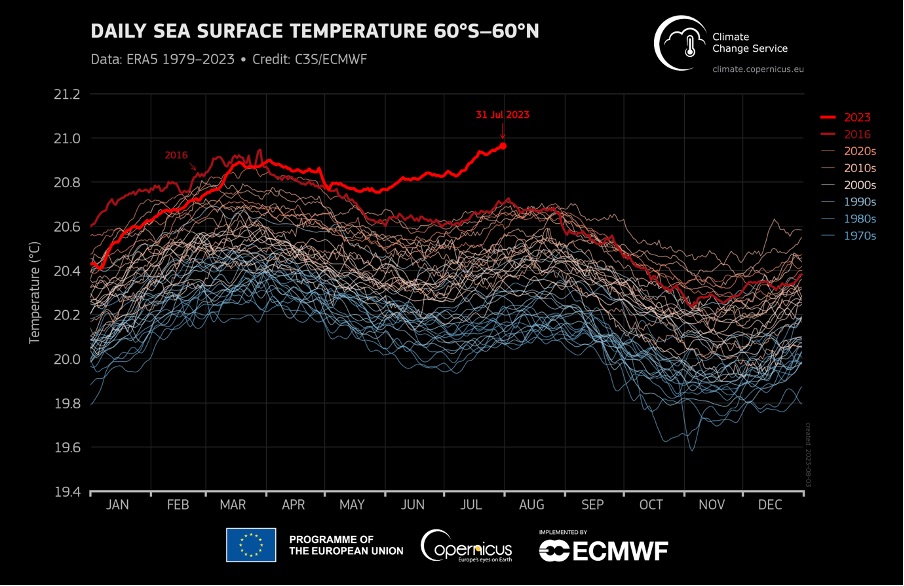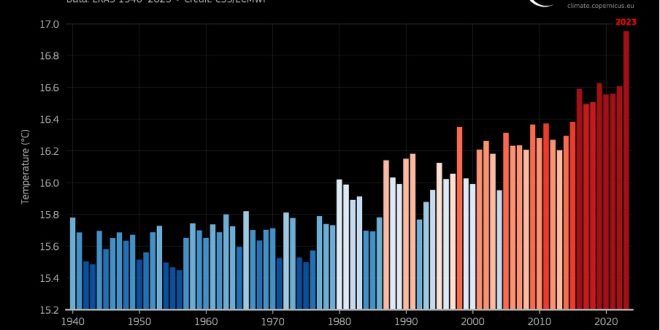In a stark revelation, the Copernicus Climate Change Service (C3S) has declared, in a statement that Yemen Science received, that July 2023 witnessed the highest global surface air temperatures ever recorded in any month. This unsettling discovery, based on computer-generated analyses using billions of measurements from satellites, ships, and weather stations worldwide, underscores the urgency of addressing climate change.
Surface Air Temperature Highlights: The average global temperature for July 2023 surpassed all previous records, sitting 0.72°C higher than the 1991-2020 average for July. Moreover, it exceeded the prior warmest month, July 2019, by 0.33°C. Comparatively, July 2023 was estimated to be around 1.5°C warmer than the average for the period between 1850 and 1900. Heatwaves gripped multiple regions in the Northern Hemisphere, including southern Europe, while South American countries and parts of Antarctica experienced well-above average temperatures.
Sea Surface Temperature Highlights: Global average sea surface temperatures continued to rise, reaching record high levels in July 2023 after a period of persistently elevated temperatures since April. Throughout July, the global average sea surface temperatures were 0.51°C higher than the 1991-2020 average. Notably, the North Atlantic recorded temperatures 1.05°C above average, with the northeastern part of the basin maintaining high temperatures and the northwestern Atlantic experiencing abnormal warmth. Marine heatwaves also emerged in regions including south of Greenland and the Labrador Sea, the Caribbean basin, and across the Mediterranean Sea. El Niño conditions persisted in the equatorial eastern Pacific.

Samantha Burgess, Deputy Director of the Copernicus Climate Change Service, expressed deep concern over the escalating climate situation. She emphasized the dire consequences of more frequent and intense extreme events posed by these new temperature records. Burgess stressed the urgent need for ambitious global efforts to reduce greenhouse gas emissions, which remain the primary driver behind these alarming trends.
2023 Climate Outlook: Comparing averages for the year-to-date period from January to July, 2023 ranks as the third warmest year on record, with a temperature 0.43°C above the 1991-2020 average. This places it just below 2016 (0.49°C) and 2020 (0.48°C). However, it is predicted that the gap between 2023 and 2016 will narrow in the coming months as the current El Niño event develops and the remaining months of 2023 are expected to be relatively warm.
Sea Ice Highlights: In July 2023, Antarctic sea ice extent reached a new low for the month, with a monthly value 15% below average—by far the lowest July extent since satellite observations began. Conversely, Arctic sea ice extent was slightly below average but significantly higher than the record minimum observed in July 2020. Notable below-average sea ice concentrations were observed throughout most of the Arctic Ocean, with above-average concentrations north of the northern Siberian coast.
Hydrological Variables Highlights: July 2023 saw above-average precipitation across several regions, including northern Europe, the Black Sea region, Ukraine, northwestern Russia, northeastern North America, Afghanistan, Pakistan, northeastern China, northern and eastern Australia, and Chile. Conversely, drier-than-average conditions were observed across the Mediterranean basin, particularly impacting Italy and southeastern Europe, as well as regions beyond Europe such as Mexico, the southwestern United States, central and southeastern Asia, southwestern Australia, and parts of southern Brazil and Paraguay.
The startling findings from July 2023 underscore the urgent need for global action to combat climate change. As temperatures continue to soar and extreme events become more frequent and intense, it is imperative that ambitious efforts to reduce greenhouse gas emissions are prioritized. Only through collective action and mitigation strategies can humanity mitigate the dire consequences of the changing climate.
 الشبكة اليمنية للعلوم والبيئة (يمن ساينس) موقع يهتم بأخبار العلوم والتكنولوجيا والصحة والبيئة والسكان
الشبكة اليمنية للعلوم والبيئة (يمن ساينس) موقع يهتم بأخبار العلوم والتكنولوجيا والصحة والبيئة والسكان





